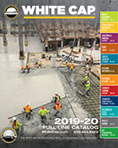Protecting Your Flatwork
Concrete Finish Work Is On The Rise
Flatwork and decorative concrete contractors are benefiting as building owners and designers realize the payoff of tastefully exposed concrete surfaces. Not only are they less costly to maintain, but they also offer eye-pleasing aesthetics with increased light reflectivity. The integration of craftmanship and innovative products have resulted in a reduced need to cover concrete slabs with tile, carpet and wood. As a result, polished concrete floors now account for nearly 60% of interior floors.
Exposed Concrete Is The “New Normal”
Concrete contractors welcome the increased business activity, but they also face an added challenge with this new normal, as final troweled surfaces are often becoming the final floor. Protecting their finished surfaces from construction and repair activity that follows placement is an important pre-job consideration with the general contractor and fellow subcontractors. Adequate surface protection is in everyone’s best interest as it can avoid costly callbacks and minor repairs due to scratches, pop-outs and stains.
While there are a wide range of floor protection products, many are not designed for concrete surfaces. Fortunately, contractors can opt for products specifically designed for concrete surfaces. These specialized materials offer greater floor protection than traditional coverings like red rosin and plastic sheeting. They have surface features that mitigate color damage from sources like rusting rebar, steel pail containers, and rainwater runoff. These thicker, more durable products also have puncture and tear-resistant qualities that can guard textured concrete surfaces. And these products allow better moisture transfer to increase the slab’s surface durability.
Why Protect A Concrete Surface Differently?
Unlike tile, carpet, or wood floors, freshly placed interior concrete floor surfaces require time to fully cure. In very general terms, the concrete surface will reach its full strength in about 28 days. While most concrete surfaces achieve enough strength in 48 hours to allow walking, there are three main reasons to protect freshly placed concrete for the full 28 days.
-
Less Grinding
Concrete polished slabs are probably the most vulnerable during this curing period. During the placement process, finishers try to draw up as much “cream” to the upper surface to help achieve a consistent appearance across the entire area. When the polishing contractor returns, their machines first slice off the cream’s crust and then grind the exposed aggregate and cement to the polished level. If the concrete surface has been pitted or chipped, they are forced to go deeper into the paste, lengthening the process.

-
Stains and Dusting
Secondly, during this first month of life, the surface is also vulnerable to stains, coloring, and even potential dusting. The cement particles are still growing together in this early period. Protection from coffees, oils, and construction chemicals is extremely important, as some chemicals could react with the hardening concrete to mar the color and texture.

-
Moisture Movement
And the third important consideration in the protection of a freshly placed concrete floor is moisture movement. Following placement, contractors install a curing membrane on the concrete surface. This membrane is designed to help retain the moisture in the slab which, in turn, increases concrete strength. The odds for a more durable concrete surface increase the longer the curing material goes undisturbed. Once the curing solution does its job, the concrete needs to breathe. The excess moisture is often drawn upwards through the slab into the structure’s interior. To minimize potential slab curling at both saw cuts and joints, this drying action must be consistent across the entire slab.

Three Levels of Protection
By specifying a surface protection covering design for concrete the floor, contractors can minimize any future surface defects and ensure the likelihood of a durable surface.
Heavy Duty Protection
On many projects the concrete floor is placed early in the construction sequence. Within 48 hours, other crafts may need to work on its surface. When these tasks include heavy ladders, equipment, and wheeled equipment such as aerial lifts and small tele-handlers, contractors must protect the surface with a very durable covering.
Temporary flooring products provide a high level of floor protection for these heavy-duty applications. These custom designed hard-board surfaces have replaced the old method of using large, bulky sheets of Masonite due to their ease of installation and storage for reuse. The flexible durable material rolls out fast, and quickly flattens to avoid any humps or trip hazards. The most advanced of these products are treated on the upward surface with a liquid permeance product that virtually eliminates the possibility of a spill permeating into the surface below.
Another important feature of temporary flooring is that contractors can create a monolithic surface by using high density tapes to cover seams. The resulting surface is fully protected from water or chemical intrusion.
Many contractors can reuse these temporary flooring products due to the material’s durability. When it becomes necessary to replace them, these products are man-made materials that are 100% recyclable, making disposal easy.
Medium Duty Protection
On many projects, certain trades will offer limited access to surfaces. These types of work could include controlled wiring, lighting, and finish carpentry. In these situations there are several types of floor protection that meet the economical means of a project.
Plastic corrugated floor protection is a versatile product designed to provide reusable surface protection for floor surfaces during construction. Plastic corrugated floor protection products are high impact twin-wall plastic sheets, made from polypropylene copolymer. Most plastic corrugated floor panels are manufactured from recycled plastic, and are extremely lightweight, yet resistant to tears, punctures and impact.
Most plastic corrugated floor panels are manufactured from recycled plastic, and are extremely lightweight, yet resistant to tears, punctures and impact.
These units are very effective in providing protection in non-controlled environments as they are unaffected by water. They won’t rust, rot, mildew or corrode.
Another alternative for very active construction sites are fiberglass or nylon reinforced coverings. The coating is a lamination of two layers of kraft paper, reinforced with a non-staining adhesive. These products provide greater strength and higher water resistance than common red rosin or thin construction paper. They protect the slab from scratches, scuffs, dirt and spills by other construction trades. They are durable enough to last through the various phases of construction to the walk-through “show” traffic after the building is completed.
They are durable enough to last through the various phases of construction to the walk-through “show” traffic after the building is completed.
These fiberglass reinforcement coverings provide rip-stop protection that limits tearing. These products are permeable, allowing moisture vapor to pass more easily than plastic films. This feature means that fiberglass reinforced coverings are less likely to trap moisture vapor, which is known to condense and puddle beneath other less permeable protection materials, water staining finished floors.
Light Duty Protection
Contractors performing light repair work on concrete surfaces can protect the floor’s finish and luster with three easy-to-use products.
 Kraft Paper
Kraft Paper
For very light and temporary work, construction grade kraft paper is a versatile alternative to plastic coverings. Kraft paper is useful when the work upon includes non-liquid construction chemical insulation spraying, caulking, and glazing.Concrete contractors often kraft paper to protect slabs when filling saw cuts.Kraft paper can easily be cut to the proper shape and will not bunch during the project. Due to its lightweight and durability, contractors can use kraft paper to protect polished counter tops and sinks. Another advantage of kraft paper is that it is 100% organic and bio-degradable allowing easy disposal.
 Corrugated Cardboard
Corrugated Cardboard
Corrugated cardboard is a better floor protection choice for those small projects with a little more exposure to heavy foot-traffic hand-pulled carts. Corrugated cardboard comes in rolls that workers can easily lay out over large areas or to create aisles. Corrugated cardboard provides an additional benefit for textures concrete surfaces. The material is thicker than kraft paper and provides a cushioning effect.The give in the cardboard provides protection for acid etched and stamped surfaces with floors surface relief. Corrugated cardboard is also flexible enough to allow workers to bend it over edges and around columns. Most corrugated cardboard products will wick moisture away from the floor surface. Even so, contractors should monitor the material after placement to ensure that there is no pigment transfer from the slab to the cardboard.
 Polyethylene Film Mats
Polyethylene Film Mats
For very small and extremely light duty protection consider using precut polyethylene film mats. Their upper surfaces feature a tacky surface that remove dust and dirt from footwear. And these special products feature a sturdy, reusable platform constructed of rigid polystyrene, available with a nonskid backing that holds it securely to the concrete floor surface with causing damage.
![]()
Who’s Responsible to Protect Your Work After You’re Done?
https://www.ascconline.org/SlabProtection





